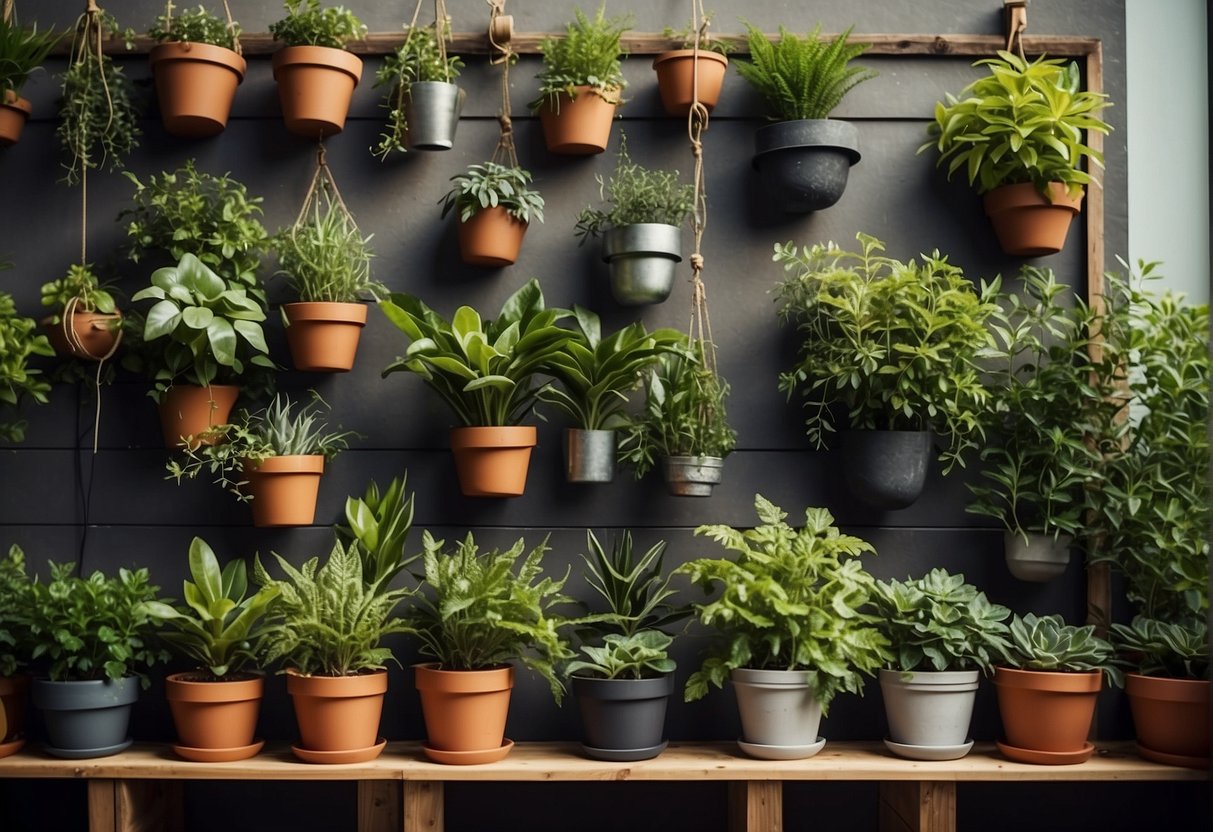Space-Saving Tips for the Urban Green Thumb
Indoor vertical gardening is a creative and space-efficient way to bring a bit of greenery into any home, particularly for those living in urban areas with limited outdoor space. It’s a flexible gardening approach that employs vertical space to grow plants, whether it’s a wall, a trellis, or even the side of a cabinet. As DIY enthusiasts know, the charm of making your own vertical garden is not just in the cultivation of plants, but also in the personal touch and design that goes into creating the structure that supports them.

For garden lovers looking to experiment with indoor vertical gardens, the possibilities are truly endless. With materials that can range from upcycled pallets to modular planters, the DIY route allows for personalization that can suit any style or space requirement. These hanging gardens not only serve as living art but also improve air quality, bringing a natural and calming element into the home.
Crafting an indoor vertical garden can involve simple projects like attaching small containers to a wall in a pattern or more involved endeavors that transform entire walls into lush botanical displays. Easy access to herbs, the joy of growing flowers, or the challenge of nurturing a variety of houseplants vertically ensures that there’s something in vertical gardening for every level of DIY enthusiast.
Getting Started with DIY Vertical Gardening

Embarking on a DIY vertical gardening project begins with understanding the essentials: location, plant types, and the climate inside your living space. These fundamentals set the stage for a thriving vertical garden.
Choosing the Right Location
The search for the perfect spot for an indoor garden must consider the sunlight availability. A location near a window that receives ample natural light promotes healthier plant growth. For those with less light, adding grow lights can compensate for the lack of sunlight, ensuring plants get their necessary dose of light.
Selecting Suitable Plants
When creating an indoor herb wall garden, selecting the right plants is crucial. They should thrive in limited soil volume and require comparable amounts of water and light to coexist peacefully. Herbs such as basil, mint, and thyme are excellent starters, as well as small vegetables like lettuce and strawberries.
Understanding Climatic Conditions
Understanding the climatic conditions within an indoor environment helps in choosing plants that are more likely to succeed. It’s essential to maintain consistent temperature and humidity levels to mimic the plants’ natural habitats. Monitoring tools might be required to keep these factors in check and ensure the optimal growth of your vertical garden.
Designing Your Indoor Vertical Garden

When space is at a premium, indoor vertical gardens offer an innovative way to bring greenery into the home. They utilize vertical space, allowing for a variety of plants to thrive in a compact area.
Structuring with Shelves and Trellis
Shelves serve as the backbone for many indoor vertical gardens. Home gardeners can choose from floating shelves, ladder-style shelves, or even modular units to fit their aesthetic and spatial needs. When incorporating a trellis, one might use a slender wooden frame to support climbing plants like ivy or clematis, helping to create a living piece of art.
Examples of Shelving Units:
- Floating shelves: sleek and modern
- Ladder shelves: rustic and charming
- Modular units: customizable and adaptable
Ideal Plants for Trellises:
- Ivy: evergreen and easy to grow
- Clematis: vibrant and flowering
Creating Hanging Gardens with Ropes and Hooks
Hanging gardens bring a sense of whimsy and vertical depth to indoor spaces. By using sturdy ropes and secure hooks affixed to the ceiling, one can dangle pots or cascading planters at varying lengths. This not only creates a dynamic visual but also allows for optimal light exposure to each plant.
Materials for Hanging Gardens:
- Natural fiber ropes, for a touch of elegance
- Heavy-duty hooks, ensuring safety and stability
Utilizing Upcycled Containers
An upcycled vertical garden breathes new life into once-discarded items. Creative individuals can transform tin cans, plastic bottles, or old rain boots into unique planters. By attaching these containers to a wooden frame or mounting them directly to the wall, one can cultivate an eco-friendly garden filled with herbs, flowers, or even small vegetables.
Ideas for Upcycled Planters:
- Tin cans: industrial look, perfect for herbs
- Plastic bottles: great for propagating cuttings
- Footwear: quirky and eye-catching displays
Building Your Vertical Garden

In this section, garden enthusiasts can discover how to build their own DIY vertical gardens, transforming limited indoor spaces into vibrant areas of greenery. They’ll learn the specifics for constructing three types of gardens: living walls, vertical herb gardens, and rainbow vertical gardens, each providing a unique aesthetic and functional experience for the home.
Putting Together a Living Wall
To create a living wall, one needs to choose the right materials: a frame, plastic sheeting, fabric, a watering system, and of course, an array of plants suited for indoor living. One starts by constructing a frame, often wooden, that can support the weight of the garden. They’ll then layer plastic sheeting and fabric, creating a foundation for water retention and plant support. It’s essential to install a reliable watering system that reaches all plants evenly. An enthusiast might opt to arrange plants by their water and light needs, ensuring a lush, healthy living wall.
Assembling a Vertical Herb Garden
For those looking to cultivate culinary delights, a vertical herb garden is both practical and space-saving. One should gather individual pots or a vertical stacking planter, suitable soil, and a variety of herb seeds or seedlings. After securing the pots or planters to a wall or stand, they’ll fill each container with soil and plant their choice of herbs, such as basil, rosemary, and thyme. It’s important to consider access to sunlight and ease of harvesting when determining the layout.
Crafting a Rainbow Vertical Garden
A rainbow vertical garden brings a burst of color to any indoor space. One needs to consider plants of varying hues and textures to achieve the rainbow effect. By selecting flowers like marigolds, petunias, and pansies or vibrant foliage plants, and arranging them in a color-graduated pattern, the builder can form a stunning, natural rainbow. They should ensure each species’ care requirements are met and that there’s enough space for growth, so the garden maintains its beauty and structure over time.
Plant Care and Maintenance

Effective plant care and maintenance are crucial for a thriving indoor vertical garden. She’ll want to ensure that her efforts are successful by paying close attention to watering and nutrients, as well as protecting her verdant wall from wind and rain. Additionally, she’ll have to stay vigilant against pests and diseases.
Watering and Nutrients
Proper hydration and nutrition are essential for plants in a vertical setting. They prefer consistent moisture, which can be effectively managed through a drip irrigation system. This allows water to reach the roots without excess waste or spillage. When it comes to nutrients, a balanced liquid fertilizer that caters to the specific needs of the plants in the vertical garden should be applied regularly, but cautiously to prevent overfeeding.
Guide to Watering and Nutrient Schedule:
- Watering: Check the topsoil. If dry, water until it starts to drain from the bottom.
- Nutrients: Utilize a half-strength fertilizer solution every two to four weeks.
Protecting from Wind and Rain
While indoor gardens are generally shielded from the elements, drafts or leaks could pose a problem. They need protection from strong winds that might blow through open windows, which could dry plants out quickly. To mitigate this, one could position her vertical garden in an area less prone to drafts. As for rain, any indoor leaks that might simulate unexpected rainfall need to be fixed to prevent overwatering and potential water damage.
Safe Zones for Vertical Gardens:
- Wind Protection: Behind a room divider or near a wall, away from frequently opened windows or doors.
- Rain Shelter: Ensure ceilings and windows are well-maintained to avoid drips.
Dealing with Pests and Diseases
Pests and diseases can quickly spiral out of control in a vertical garden due to the proximity of plants. She should inspect her garden regularly for signs of distress such as wilting, discoloration, or unusual spots. Non-toxic insecticidal soaps or neem oil can help manage outbreaks. Maintaining good air circulation and cleanliness also reduces the risk of issues cropping up.
Action Points for Pests and Disease Prevention:
- Inspection: Weekly check-up for early signs of trouble.
- Treatment: Use neem oil on affected areas as soon as pests or disease are detected.
Creative Ideas and Personal Touches
Vertical gardening is a canvas for the imaginative DIY enthusiast—it’s a chance for garden lovers to inject personality into their urban green spaces. With the right blend of creativity, they can transform humble terra cotta pots into lively, wall-mounted herb gardens. One might choose to paint the pots in vibrant hues or draw intricate patterns to make each herb station a piece of art.
For those with a sweeter tooth, growing strawberries vertically not only saves space but also becomes a talking point. By stacking pots or using a hanging system, strawberries can cascade down, adding a pop of red and delightful fragrance to the room. It’s a practical yet charming way to bring the garden indoors.
| Indoor Vertical Garden Ideas | Benefits |
|---|---|
| Painted Terra Cotta Pots for Herbs | Aesthetic Appeal, Customizable |
| Strawberry Towers | Space-Efficient, Fruitful Harvests |
| Flower Wall | Sweet Scents, Visual Diversity |
| Hanging Herb Mason Jars | Ease of Access, Rustic Charm |
Flowers shouldn’t be overlooked; they bring a burst of color and life to indoor environments. They can curate a flower wall that serves as a living painting, changing with the seasons. Utilizing vertical space allows them to showcase a variety of blooms, creating a quilt of colors and textures.
Lastly, herbs are the gardener’s practical companion, and growing them vertically means they are always within reach for culinary adventures. Mason jars or recycled containers can be adorned with labels and twine, solidifying that hand-touched feel gardeners pride themselves on. Nothing says ‘homegrown’ quite like a sprig of basil or mint, plucked straight from a personally crafted indoor oasis.





